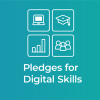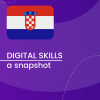CrAL - Creative Audiovisual Lab, Croatia
The Creative Audiovisual Lab for the Promotion of Critical Thinking and Media Literacy is a cross-border project, running in 6 European countries: Croatia, Belgium, Spain, Greece, Lithuania, and Italy. Funded by Erasmus+ and coordinated by ALL DIGITAL, the project's goal is to enhance critical thinking and media literacy amongst learners, parents and educational staff. In Croatia, project activities are managed by the Centre of Technical Culture Rijeka (CTC Rijeka). The project started in 2021 and is set to finish in January 2024.
Background
CrAL targets young people between the ages of 14 to 19, and especially those youngsters with insufficient media literacy skills. The aim of the project is to offer the necessary tools and knowledge to 'digital natives' and thereby improve their understanding of the world they live in, as well as their media literacy and critical thinking skills. But why digital natives?
Generation Z falls within this category of digital natives. But even though youngsters grew up with digital technologies, this does not necessarily mean that they are tech savvy by default. Digital natives grew up in a world where audiovisual online content is everywhere: and even though they interact with technology every day, they often lack the ability to think critically and assess the information they receive. This is very much the case with content coming from media - and they often risk becoming victims of disinformation, especially in view of the limitless amount of information one can find online.
Objectives and aims
CrAL is not just aimed at young people, but also at the whole community, which engages with them every day. For example, the project aims to train also teachers in secondary schools, as well as training providers from vocational and non-formal environments, supporting them in empowering their students to think critically and assess the quality and relevance of the information they find online. Parents and school admin staff are also involved. As such, the project's goals are to:
- Improve the knowledge and training of teachers and parents so that they know how to educate students in creative audiovisual reading, writing and content creation, with a focus on media literacy.
- Offer a blended course, following a sound methodology for creative audiovisual writing and reading, together with online video lessons via the CrAL virtual platform for teachers and trainers in each of the 6 European countries the project is running in.
- Empower students to critically interpret, assess and produce audiovisual content, enhance critical thinking and promote the development of media literacy competences and skills.
- Create an Audiovisual Literacy programme, which rests on critical and out-of-the-box thinking.
Why is this a good practice?
The project applied and scaled up the Italian good practice “Creative audio-visual writing and reading”, developed as a result of the research carried out within the Laboratory of Image and Creative Writing held at the University “La Sapienza” of Rome by Annio Gioacchino Stasi and Mery Tortolini, to five different education systems and contexts – Croatia, Greece, Italy, Lithuania, and Spain.
Firstly, partners adapted the good practice “Creative audio-visual writing and reading” to their contexts and design the model for setting up Creative Audiovisual Labs.
Secondly, they trained educators (teachers and trainers) to implement the Creative Audiovisual Labs. This happened through a blended course consisting of 10 modules covering technical, digital, and creative skills.
Finally, trained teachers and trainers set up Creative Audiovisual Labs and work with their students. Students produced films on selected topics such as migration, tolerance, and other topics that are interesting to them and important in today’s society.
As such, the project facilitated the acquisition of digital skills, but also soft skills, following the competences of the EU DigComp framework: Communication, Collaboration, Creativity, Problem-solving, etc. CrAL was also designed with vulnerable people in mind, and promotes the social inclusion of disadvantaged groups such as migrants. It also increased public awareness for schools, education systems, teachers, parents and related communities, focusing on the value of audiovisual content as a means to develop critical thinking and digital inclusion. Its transnational dimension was reflected in the diversity of the partners taking part in the project, who include also EGInA and the Istituto Centrale per I Beni Sonori e Audiovisivi (ICBSA) in Italy, the Universitat Autònoma de Barcelona (UAB) in Spain, the Hellenic Open University (HOU) in Greece, and the Langas į ateitį association in Lithuania.
The project was co-financed by the Executive Agency for Education, Audiovisual and Culture of the European Commission, the Office for Associations of the Government of the Republic of Croatia and the Agency for Electronic Media.




